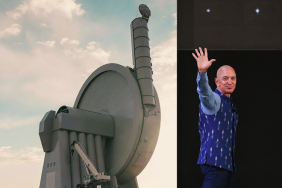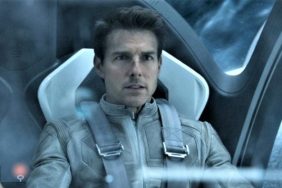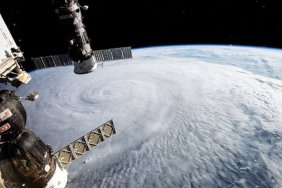Photo: This image of the Sombrero Galaxy is a mosaic of six images taken by the Hubble Space Telescope’s Advanced Camera for Surveys in May and June 2003 (exposition time: 10.2 hours). Made between May – June 2003. © NASA/ESA and The Hubble Heritage Team (STScI/AURA). Courtesy of Wikimedia Commons.
Just four hundred years ago, in 1609, Italian polymath Galileo Galilei had a vision of the universe. He defied the Roman Catholic Church’s edict that espoused the sun revolved around the earth, inventing the telescope to prove his hypothesis correct. He believed the earth revolved around the sun—and what was more, he began mapping out the solar system.
Also: “This Is Mars” Takes You on a Fantastic Voyage to Another World
His work created backlash; he was accused of heresy and subjected to trial at the hands of the Inquisition. Found guilty, he was placed under house arrest for the remainder of his life, and the publication of existing and future works were banned and forbidden.

Astronaut F. Story Musgrave, anchored on the end of the Remote Manipulator System (RMS) arm, prepares to be elevated to the top of the Hubble Space Telescope (HST) to install protective covers on the magnetometers. Astronaut Jeffrey A. Hoffman inside payload bay, assisted Musgrave with final servicing tasks on the telescope, wrapping up five days of space walks. Released December 9, 1993. Courtesy of Wikimedia Commons.
Today we look back at Galileo’s work and recognize him as the father of observational astrology, modern physics, and the scientific method. His work proved that science did not dispute the laws of God but rather the laws of the Church, whose power has since waned under the weight of its own abuses.
At the same time, the principles Galileo set in motion provided a foundation upon which so much has been built, perhaps most visually impressive, the work of NASA’s Hubble Space Telescope. The Hubble was launched into space in 1990, orbiting 340 miles above the Earth’s surface, looking out into the distant universe. Its cameras gaze beyond the distorting effects of the atmosphere, enabling it to observe astronomical objects with superior detail than attainable on earth.
Over the past three decades, the Hubble has become one of the most impressive sources informing our understanding of the universe. Its cameras and spectographs can record everything from a nearby collision of asteroids to distant star-forming galaxies that date back to when the universe was only three percent of its current age. In its brief time in orbit, the Hubble has played a key role in discovering and characterizing the mysterious dark energy that now appears to permeate space, changing our fundamental understanding of the cosmos.

In celebration of its achievements, NASA has released a free booklet that showcases the Hubble’s greatest hits. Organized into 13 sections, the booklet takes readers on an impressive tour through outer space, and revealing amazing distant worlds. We witness the death throes of stars in all their vibrant glory and the amazing mergers that occurs when galaxies collide, as well as the mysteries of our own solar system and its incredible formations.
The Hubble has proven itself to be an indispensable craft for professionals in the field and amateur star-gazers alike. The images it has produced have informed not only our understanding of the universe but the culture in which we live, appearing everywhere from book and album covers to ecclesiastical stained-glass windows. Galileo would be proud—and redeemed.
Miss Rosen is a journalist covering art, photography, culture, and books. Her byline has appeared in L’Uomo Vogue, Whitewall, The Undefeated, Dazed Digital, Jocks and Nerds, and L’Oeil de la Photographie. Follow her on Twitter @Miss_Rosen.
Hubble Space Telescope
-
Highlights from the Hubble Space Telescope

Star forming pillars in the Eagle Nebula, as seen by the Hubble Space Telescope's WFPC2. © NASA, Jeff Hester, and Paul Scowen (Arizona State University). Courtesy of Wikimedia Commons.
-
Highlights from the Hubble Space Telescope

To commemorate Hubble Telescope's 20th Birthday, NASA, along with ESA and M. Livio and the Hubble 20th Anniversary Team (STScI), released several of Hubble's findings. Released April 2, 2010. © NASA, ESA, and M. Livio and the Hubble 20th Anniversary Team (STScI). Courtesy of Wikimedia Commons.
-
Highlights from the Hubble Space Telescope

In January 2002, a dull star in an obscure constellation suddenly became 600,000 times more luminous than our Sun, temporarily making it the brightest star in our Milky Way galaxy. The mysterious star, called V838 Monocerotis, has long since faded back to obscurity. But observations by NASA's Hubble Space Telescope of a phenomenon called a "light echo" around the star have uncovered remarkable new features. These details promise to provide astronomers with a CAT-scan-like probe of the three-dimensional structure of shells of dust surrounding an aging star. Released March 4, 2004. © NASA and The Hubble Heritage Team (AURA/STScI). Courtesy of Wikimedia Commons.
-
Highlights from the Hubble Space Telescope

Galaxy NGC 1569 as imaged by the Hubble Space Telescope. Released February 3, 2004. © ESA, NASA and P. Anders (Göttingen University Galaxy Evolution Group, Germany. Courtesy of Wikimedia Commons.
-
Highlights from the Hubble Space Telescope

The grand-design spiral galaxy Messier 74 as photographed by the Hubble Space Telescope. Released November 29, 2007. © NASA, ESA, and the Hubble Heritage (STScI/AURA)-ESA/Hubble Collaboration. Acknowledgment: R. Chandar (University of Toledo) and J. Miller (University of Michigan). Courtesy of Wikimedia Commons.
-
Highlights from the Hubble Space Telescope

Messier 69 global cluster as photographed by the Hubble Space Telescope. Released August 14, 2008. © NASA. Courtesy of Wikimedia Commons.
-
Highlights from the Hubble Space Telescope

This image of the Sombrero Galaxy is a mosaic of six images taken by the Hubble Space Telescope's Advanced Camera for Surveys in May and June 2003 (exposition time: 10.2 hours). Made between May – June 2003. © NASA/ESA and The Hubble Heritage Team (STScI/AURA). Courtesy of Wikimedia Commons.
-
Highlights from the Hubble Space Telescope

Astronaut F. Story Musgrave, anchored on the end of the Remote Manipulator System (RMS) arm, prepares to be elevated to the top of the Hubble Space Telescope (HST) to install protective covers on the magnetometers. Astronaut Jeffrey A. Hoffman inside payload bay, assisted Musgrave with final servicing tasks on the telescope, wrapping up five days of space walks. Released December 9, 1993. Courtesy of Wikimedia Commons.
-
Highlights from the Hubble Space Telescope

The Hubble Space Telescope (HST) begins its separation from Space Shuttle Discovery following its release on mission STS-82. © NASA. Courtesy of Wikimedia Commons.








